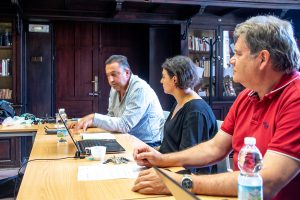Multimedia learning occurs when a learner builds a mental representation from words and pictures that have been presented (R. Mayer, 2017). Multimedia instructional messages using words and pictures (for instance static graphics, photos, drawings, amps, or charts) are intended to foster learning. These facts can also be used in typical training in Vocational Education and Training. Mayer describes his research work in implementing multimedia content in the teaching and training process in the Cambridge Book of Multimedia Learning.
Video as media in training
The importance of using media in teaching, training, and learning was made visible at the Media & Learning Meeting 2018 (Leuven, Belgium). The fact that more than half of the European universities use videos in teaching was the reason to assemble educators from universities to discuss the topic and to develop strategies and settings of a most efficient use of media.
Differences in the TIBL-project

Discussion at the teaching event: How to use multimedia in courses? Special guest is Andreia Inamorato dos Santos (from the JRC)
In the TIBL-Project the use of media is a must – the project partners promote multimedia material and interactive training material for the training.
An important issue is to use interactive video: Videos are a kind of “one-way material” and can give you the knowledge to do something. For example, you use a YouTube video to exchange your broken laptop display. After you have done you have the typical forgetting course and after some hours you have completely forgotten everything.
Therefore, the project group developed the use of interactive videos used in the MOODLE environment of the project. These interactive videos and other interactive multimedia material provide a better training result (and finally make more fun during the training).
Theory behind
Mayer describes the fundamental principle behind multimedia learning as “People learn
better from words and pictures than from words alone.” This means that using both words and pictures is more effective than
words alone. Mayer also researched that narration and video appear to be more effective than narration, video and text (I would call it “overloaded multimedia).
Conclusion
Following these ideas, it also would make sense to create multimedia based PowerPoints (with a minimum of text) and add voice. These slides could be used online (for distance learning) as well.
Technical comments
Creating multimedia content must be planned well, is time consuming and needs a high level of competences. Shared material (as Open Educational Resources) are a way to offer not so well-educated people high quality multimedia-based material.
References:
Richard E. Mayer, in: Psychology of Learning and Motivation, Volume 67, Pages 1-318 (2017), Edited by Brian H. Ross
Mayer (2014): The Cambridge Handbook of Multimedia Learning, Second Edition: Cambridge University Press.